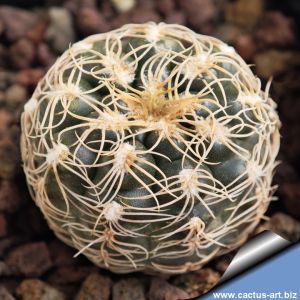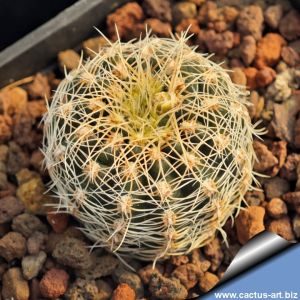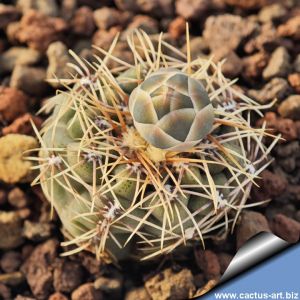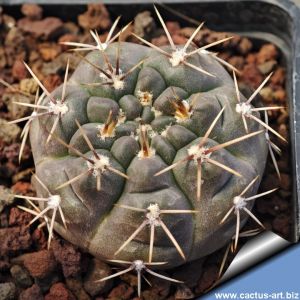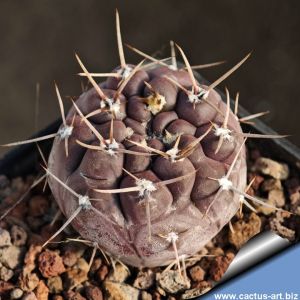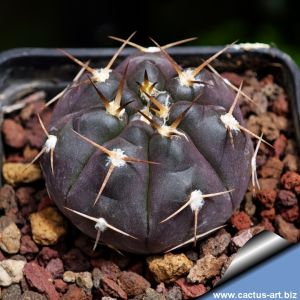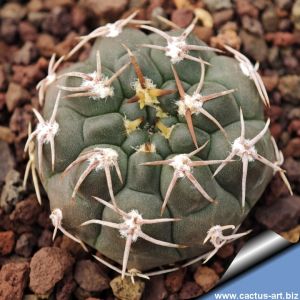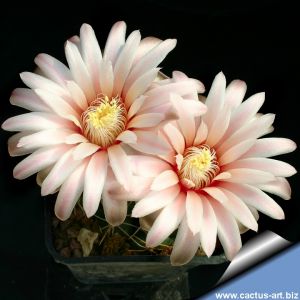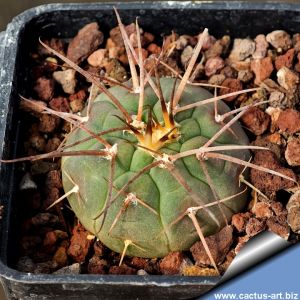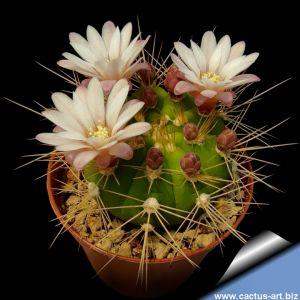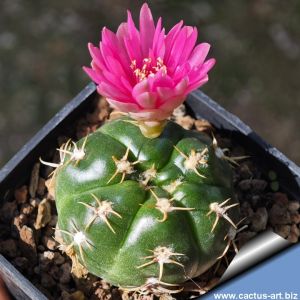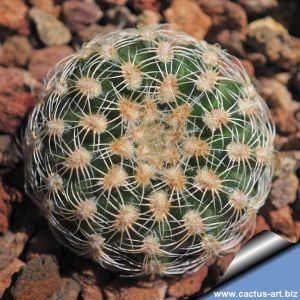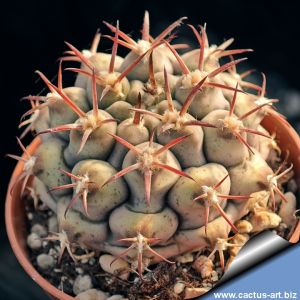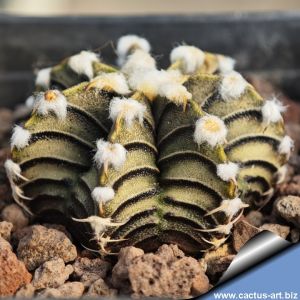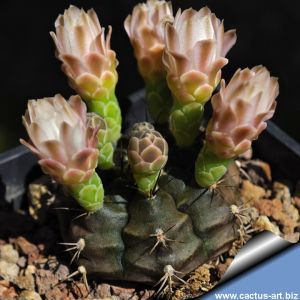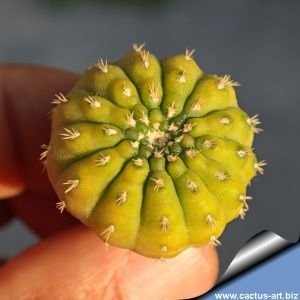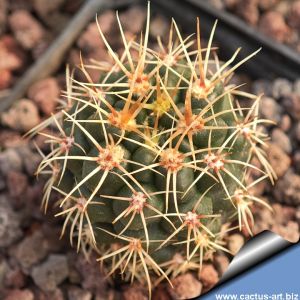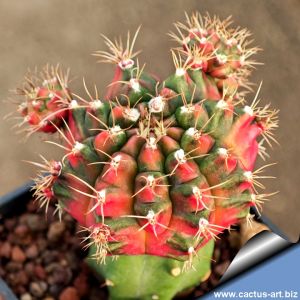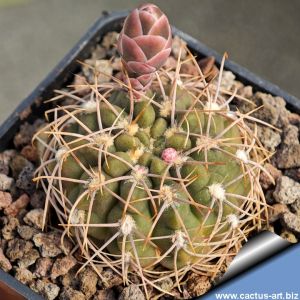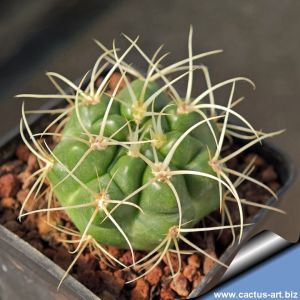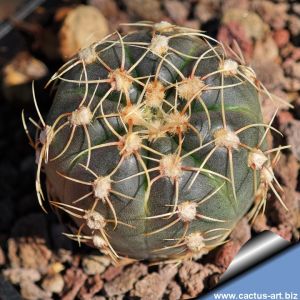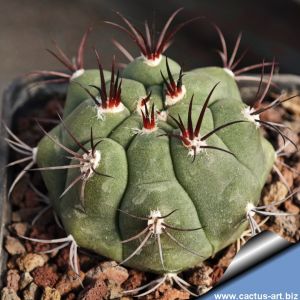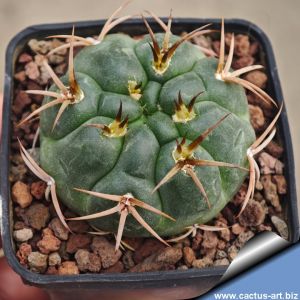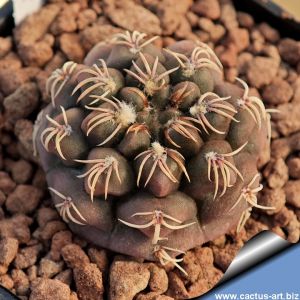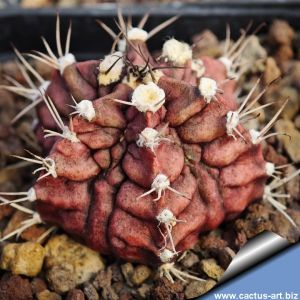-
1
A solitary, strongly armed cactus with impressive spines. Stem dark green, depressed globose, deeply notched, with prominent, chin-like tubercles. Spines stout, thick, and curving, yellowish or amber-colored with darker tips, turning grey with age.
-
2
Diminutive globose species with a subtly flattened apex and barely pronounced tubercles. The ivory-colored spine clusters radiate like tiny spider legs, creating an enchanting starburst pattern against the
plant's matte green epidermis.
-
3
Slow-growing globose cactus with slightly flattened top and soft white spider-like spines. Stunning pink-magenta flowers (6 cm wide) crown the apex in late spring/early summer.
-
4
Fresh new species, long centrals. Flower creamy-white with bright pink throat.
-
5
Flower funnel-shaped, shiny white with a distinct smell of lilac.
-
6
Gymnocalycium striglianum v. aeneum – Flattened-globose body with plum-colored tubercles under a frosted silver-grey bloom. A metallic-hued Gymno gem! Prized for its unusual coloration. VERY RARE! Few available.
-
7
A stunning plant with a flattened body in deep purple, showing metallic copper or emerald hues. It has strong, slightly curved spines. The overall appearance is dramatic, with iridescent color shifts in changing light, making ita prized specimen.
-
8
Flattened green to brownish body with flat ribs, creamy-yellow spines, and white flowers.
-
9
Notable for its strongly flattened form and well-developed tuberose
root system. The blooms exhibit delicate pinkish-white petals with a
contrasting deep pink-red central area that adds visual interest.
-
10
Flat and fat plants with fantastic spination and pretty short pinkish flowers!
-
11
Very different and easily distinguishable from other gymnocalicyum species. The new stems are light yellow-green, later grayish. Spines straight, yellow, thin, stiff, but elastic. Flowers white or light pink.
-
12
A charming Gymnocalycium hybrid with bright pink-purple flowers. The short, curled and twisted spines enhance its appeal, resulting in a truly delightful plant.
-
13
The var. pawlovskyi stands out with its more columnar growth and comb-like spines. Micro-endemic it found only in a narrow Córdoba region (Esperanza to El Camarón, north of Dean Funes). A geographic and morphological marvel.
-
14
Gymnocalycium schickendatzii v. delaetii, related to G. schickendantzii, has rounded, prominent tubercles. Globose body, blue-green or gray-green. 6-7 curved spines, grayish-yellow with red tips, fading with age. A distinctive species.
-
15
Very attractive plant with pointed ribs and pinkish-gray bodies striped with darker purple-tan bands. The areoles are very wooly and nearly spineless. The spines are weak and fall over time. The flowers are pale pink, appear freely and open up entirely.
-
16
Dark-bodied ribbed cactus that abundantly produces pearly-white flowers with pink tinges. Blooms profusely even when young, creating spectacular displays of delicate flowers that starkly contrast with the dark stem.
-
17
Exceptional flattened cultivar in yellow-green, dotted with tiny spines. Its chromatic uniqueness and architectural form make it a collector’s must-have. Limited stock.
-
18
Massive yellow blooms! Flowers while still a young seedling. Perfect for impatient growers who want quick results without waiting years for first flowers.
-
19
Beautiful multicolored cultivar with variegated stem showing sectors or patches in yellow, orange, red, and green. The visual effect is stunning and vibrant. Each specimen is unique, with a one-of-a-kind color pattern that cannot be duplicated.
-
20
Solitary flattened stem with a depressed woolly apex (spine-free). The backward-curving, interlacing spines (up to 2.5cm) are greyish or brownish with dark tips. Produces white or pale pink blooms.
-
21
A unique cactus with large white flowers. Var. steineri stands out for its golden, translucent, curved and flexible spines, arranged in fan-like clusters or intricate tangles. Compared to the typical form, it captivates with the beauty of its spine.
-
22
Native to Uruguay, this globose-flattened cactus features, spider-like spines that vary in shape and length. But its real wonder lies in the brilliant yellow flowers.
-
23
Dull green heads with with strong, curved spines! It rewards patience with lovely peach blossoms. A germination challenge: sow its dust-like seeds in a sealed jar and keep humid for a full year. The wait is absolutely worth it for the result!
-
24
A beautiful plant with dark green stem, few thick, curved spines, and short red flowers. Its simple yet bold structure and vivid blooms create a strong visual impact.
-
25
Gymnocalycium robustum (as the name suggests) is a strong, rugged cactus species with thick ribs and rounded podaria (tubercles). It bears few short spines, mostly pointing downward, and develops thick floral tubes and fleshy fruits.
-
26
A Japanese cultivar distinguished by its rough, irregular epidermis resembling reptile skin. Its ribs twist into sculptural forms, creating a primal and powerful appearance. Unique and highly sought after.


